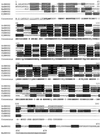Accumulation of ENOD2-like transcripts in non-nodulating woody papilionoid legumes
- PMID: 11027723
- PMCID: PMC59179
- DOI: 10.1104/pp.124.2.741
Accumulation of ENOD2-like transcripts in non-nodulating woody papilionoid legumes
Abstract
Japanese pagodatree (Styphnolobium japonicum [L.] Schott) and American yellowwood (Cladrastis kentukea Dum.-Cours.) Rudd are the first woody, non-nodulating papilionoid legumes shown to possess putative early nodulin 2 (ENOD2) genes. ENOD2 cDNAs from Japanese pagodatree (807 bp) and American yellowwood (735 bp) have 75% to 79% sequence identity to ENOD2 sequences and encode deduced proteins that possess conserved ENOD2 pentapeptides (PPHEK and PPEYQ). Lower percentages of glucose and higher percentages of histidine and valine suggest that SjENOD2 and CkENOD2 are different from other ENOD2s. Hybridization analyses indicate the clones represent ENOD2 gene families of two to four genes in Japanese pagodatree and American yellowwood genomes, and ENOD2-like transcripts were detected in stems and flowers, as well as roots. Only roots of control species that nodulate, Maackia amurensis Rupr. & Maxim. and alfalfa (Medicago sativa), produced pseudonodules after treatment with zeatin or 2,3,5-triiodobenzoic acid, an auxin transport inhibitor. Accumulation of MaENOD2 transcripts was enhanced during the first 10 d of treatment, but 2,3,5-triiodobenzoic acid and zeatin enhanced transcript accumulation after 30 d in roots of Japanese pagodatree and American yellowwood. Characteristics that distinguish ENOD2 gene families in basal, non-nodulating woody legumes from other ENOD2 genes may provide new information about the function of these genes during symbiotic and non-symbiotic organ development.
Figures





Similar articles
-
Cells expressing ENOD2 show differential spatial organization during the development of alfalfa root nodules.Mol Plant Microbe Interact. 1991 Mar-Apr;4(2):139-46. doi: 10.1094/mpmi-4-139. Mol Plant Microbe Interact. 1991. PMID: 1932810
-
Characterization of nodule-specific cDNA clones from Sesbania rostrata and expression of the corresponding genes during the initial stages of stem nodules and root nodules formation.Mol Plant Microbe Interact. 1989 May-Jun;2(3):122-7. doi: 10.1094/mpmi-2-122. Mol Plant Microbe Interact. 1989. PMID: 2520821
-
The early nodulin transcript ENOD2 is located in the nodule parenchyma (inner cortex) of pea and soybean root nodules.EMBO J. 1990 Jan;9(1):1-7. doi: 10.1002/j.1460-2075.1990.tb08073.x. EMBO J. 1990. PMID: 1688528 Free PMC article.
-
The Lotus japonicus LjNOD70 nodulin gene encodes a protein with similarities to transporters.Plant Mol Biol. 1998 Jul;37(4):651-61. doi: 10.1023/a:1006043428636. Plant Mol Biol. 1998. PMID: 9687069
-
Cooperative action of lipo-chitin nodulation signals on the induction of the early nodulin, ENOD2, in soybean roots.Mol Plant Microbe Interact. 1996 Sep;9(7):574-83. doi: 10.1094/mpmi-9-0574. Mol Plant Microbe Interact. 1996. PMID: 8810072
References
-
- Allen EK, Allen ON, Newman AS. Pseudonodulation of leguminous plants induced by 2-bromo-3,5-dichlorobenzoic acid. Am J Bot. 1953;40:429–435.
-
- Allen T, Raja S, Dunn K. Cells expressing ENOD2show differential spatial organization during the development of alfalfa root nodules. Mol Plant-Microbe Interact. 1991;2:139–146. - PubMed
-
- Arora N, Skoog F, Allen ON. Kinetin-induced pseudonodules on tobacco roots. Am J Bot. 1959;46:610–613.
-
- Batzli JM. Indigenous rhizobial diversity of Robinia pseudoacacia L. and nodulation studies of Maackia amurensis Maxim. & Rupr. and Sophora japonica L. MS thesis. College Park: The University of Maryland; 1991.
-
- Batzli JM, Graves WR, van Berkum P. Isolation and characterization of rhizobia effective with Maackia amurensis. J Am Soc Hortic Sci. 1992;117:612–616.
Publication types
MeSH terms
Substances
LinkOut - more resources
Full Text Sources

